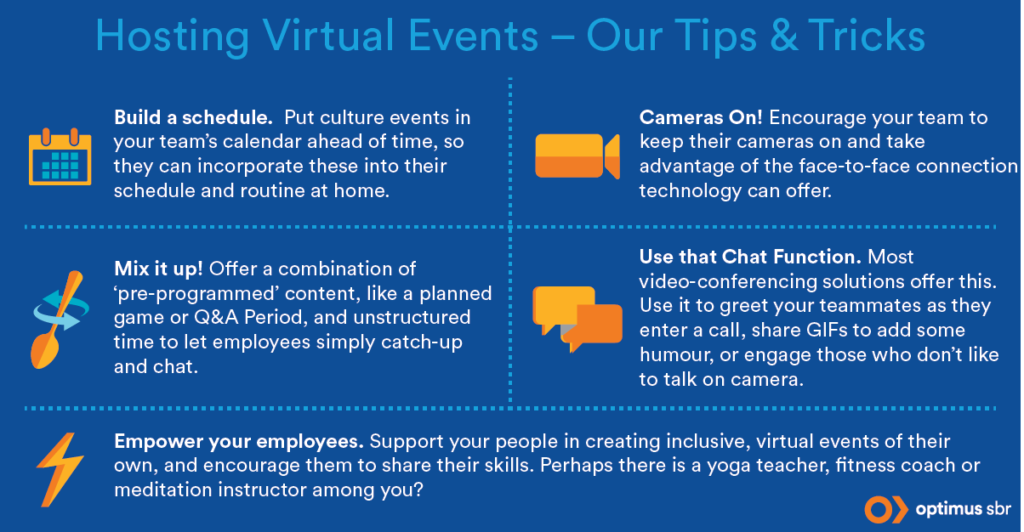Skipping the commute, exercising over breaks and making lunch in your own kitchen — working from home can sound pretty great. That’s right up until your Wi-Fi stops working, your laptop screen freezes, your dog is barking, and children are shouting in the background.
Let’s face it, many of us have encountered new frustrations and difficulties as we shift to working from home; these have been amplified in the current environment, as unfamiliar considerations like social isolation, and a need to play the role of both employee and parent, need to be addressed. Many organizations, both large and small, are currently navigating the trials and triumphs of shifting to a virtual workforce.
We’re all in this together, so we wanted to share six things we’ve learned in our first few weeks of going virtual.
- Build a workspace that works for you. Our team has found it’s best to find a quiet space where you can close the door, especially when there are others living or working in your home. As many of us are accustomed to an open-concept workspace with plenty of background noise, turning on the radio or some music can add a touch of familiarity. We’ve also shared this New York Post Piece to guide our employees in making their set-up more ergonomic. Finally, we recommend seeking out the best spot in your space for taking video calls. Use a service like Fast.com to ensure strong connectivity, and aim for natural lighting and an appropriate background. Remember, you are quite literally inviting people into your home!
- Agree on expectations. At Optimus SBR, we developed Virtual Workforce Guidelines to ensure we were all on the same page about working hours, availability, and the technology to be used for communication and collaboration. We’ve encouraged our managers to have these conversations with their teams as well, and are constantly looking for feedback about what is working well during this time. Agreeing on expectations is an important first step to success when it comes to remote work.
- Set Boundaries. Establishing boundaries is important with both the people around you, and when it comes to work-life balance. Ensure those who you are living with understand that just because you are home, does not mean you are available. We’ve indicated to our employees that when there are children in the home, shifting schedules or taking the “late shift” by working after your kids are asleep might be necessary. Just as importantly, it’s essential to set boundaries with yourself, as working from home means the lines between work time and personal time can be significantly blurred. Find a way to physically and psychologically transition out of work mode at the end of the work day. That might mean moving into a different room, getting outside (while practicing physical distancing), or turning off mobile phone notifications.
- Ramp up communications. Frequent, transparent, and informative communications are more important than ever during these times. At Optimus SBR, we are sending ‘Virtual Workforce Update’ emails from our Leadership team at least three times a week. We use these to share company news, tips for working effectively from home, and to keep employees engaged and connected. In addition, it’s critical to keep up with company-wide meetings, even if they can’t take place in person. (Schedule a practice run to ensure these run smoothly). Finally, we’ve encouraged our teams to use video calls as much as possible. In the same way you might pop over to someone’s desk, you can visit them virtually and share your screen to get quick feedback.
- Remember virtual personas. We often take for granted how much context comes from things like expression, tone of voice, and other visual cues. It’s critical to keep this in mind when communicating virtually. Take extra care to ensure the message and tone of your response will be understood as intended before clicking “send” on your email or direct message. For example, we often read a great piece of work and respond with just the one edit, typo, or concern we have. Think about the cumulative impact of that over time with an entirely virtual team…and use video calls to communicate whenever you can!
- Keep culture alive. As a firm that was built on culture, finding ways to keep employees engaged, involved, and connected during our transition to virtual has been a top priority. Earlier this week, we posted the infographic below to share some of our top discoveries when hosting virtual events to keep our teams engaged. Empowering employees on this front is key. We’ve seen plenty of employee-led initiatives, from a virtual ‘mid-day stretch’ to themed dress-up days. Empower your employees to keep the spirit of your culture alive. They will tell you what they need in order to stay engaged and connected.

We hope some of our learnings can help as your organization continues to find a new normal as a virtual workforce. After all, it’s essential that we keep working together, even while staying apart.

Optimus SBR Celebrates 6 Consecutive Wins as 2024 Best Workplaces™ in Professional Services
Our commitment to a people-first approach has been central to being recognized in 2024 for the sixth time as one of the Best Workplaces™ in Professional Services and the key to our overall success.

12 Best Practices to Increase Cross-Team Collaboration and Enhance Organizational Alignment
Enhancing cross-team collaboration drives innovation, optimizes resources, improves overall performance, and ensures every part of your organization works toward the same goals.

Enhancing Your Data Strategy for Success: The Power of Metadata
Metadata goes beyond just aiding in data retrieval. It ensures your data is secure, compliant and, most importantly, understood consistently by everyone in the organization.

Optimizing Language Translation Strategies: Beyond Compliance to Enhanced Operational Efficiency
The introduction of Quebec’s Bill 96 in Canada underscores the necessity for comprehensive translation strategies. Integrating machine translation technologies helps meet regulatory requirements while enhancing translation speed, cost efficiency, and operational effectiveness.

How to Manage Gen Z: 16 Strategies to Engage and Retain Young Talent
These practical strategies lead to a workplace that is better aligned with the values and expectations of Gen Z employees, ensuring that your efforts to attract and retain Gen Z talent are both successful and sustainable.

How to Measure the Success of Learning and Development: 12 Important Metrics to Evaluate
Quantifying the success of L&D training programs can be challenging. Learn about selecting and measuring the right metrics to determine whether your training efforts are truly making an impact.



